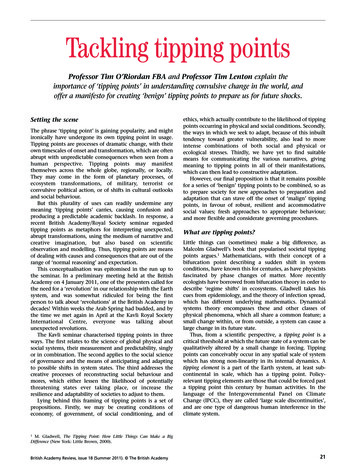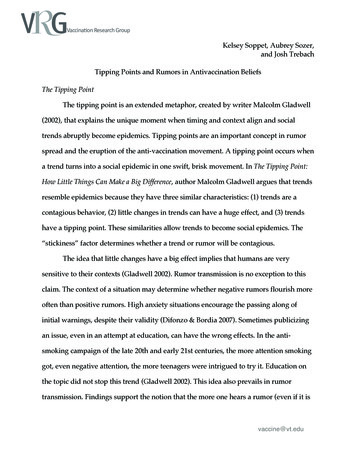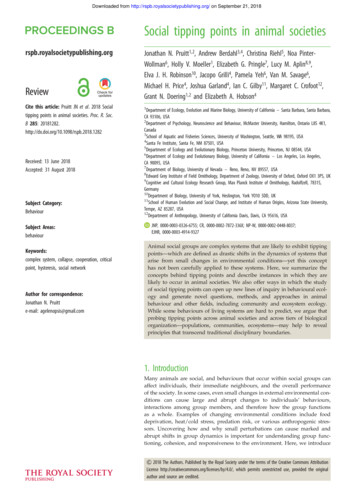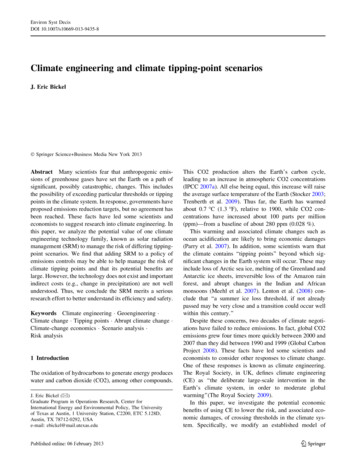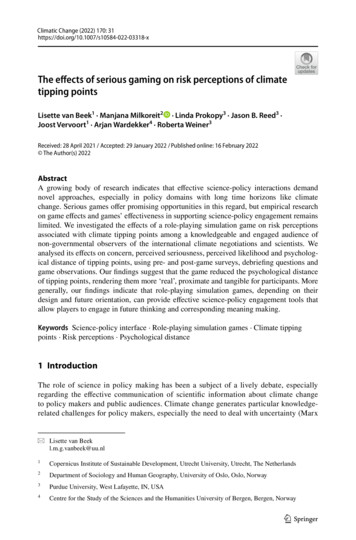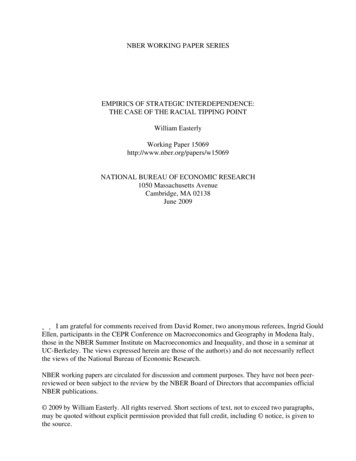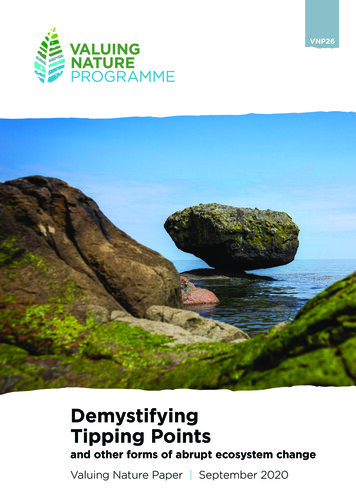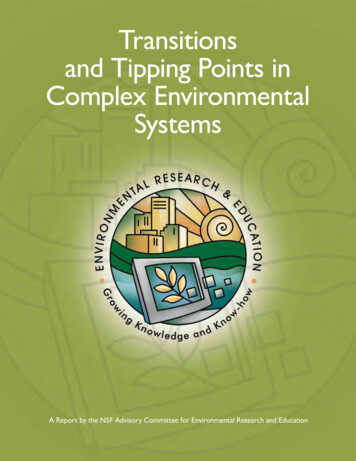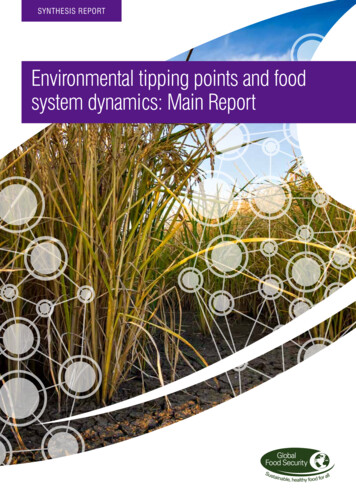
Transcription
SYNTHESIS REPORTEnvironmental tipping points and foodsystem dynamics: Main Report
ContentsThis report originates from an inter-disciplinary and inter-sectoralworking group of academics and industry experts tasked with examiningenvironmental tipping points and how they interact with food systemdynamics. The working group was led by the UK’s Global Food Securityprogramme.This main report is accompanied by an executive summary report,Environmental tipping points and food system dynamics: Executive Summary.This report is for stakeholders in the food system that have an interest in riskmanagement. This includes the agri-food industries, as well as investors and(re-)insurance, and academic and policy communities.Global Food Security (GFS) is a multi-agency programme bringing togetherthe main UK funders of research and training relating to food. GFSpublications provide balanced analysis of food security issues on the basis ofcurrent evidence, for use by policy-makers and practitioners. This report doesnot necessarily reflect the policy positions of individual partners.This report should be cited as:Environmental tipping points and food system dynamics: Main Report (2017).The Global Food Security programme, UK.AuthorsTim G. Benton (University of Leeds)Dan Fairweather (Willis Towers Watson)Anil Graves (Cranfield University)Jim Harris (Cranfield University)Aled Jones (Anglia Ruskin University)Tim Lenton (University of Exeter)Rachel Norman (University of Stirling)Tim O’Riordan (University of East Anglia)Edward Pope (Met Office)Richard Tiffin (University of Reading)Contributors*Adam Bell (Defra)Riaz Bhunnoo (Global Food Security)Allan Buckwell (Institute for European Environmental Policy)Bill Davies (University of Lancaster)Ulrike Hotopp (at the time of writing, Defra)Stuart Lendrum (Sainsbury’s)Stephen Nelson (Defra)Siobhan Sherry (Defra)Frank Sperling (University of Oxford)Sian Williams (Global Food Security)*Contributors do not necessarily represent their organisations’ viewsKey findings1Introduction2Part I: Setting out the issue4Part II: Understanding and managing 26
Key findings Environmental tipping points occur when there are step changesin the way the biophysical world works – whether loss of soilfertility, collapse of a fishing stock, or sudden changes in weatherpatterns, such as those that caused the grasslands in NorthAfrica to become deserts, 6000 years ago. These non-linear shiftsarise following a critical degree of change, resulting from eithermany small cumulative changes or one large shock, “tipping” thesystem over a threshold and into a new stable state. Entering analternative stable state is associated with a change to systemfunction, usually being difficult to reverse or “tip” back into theoriginal state. Increasingly we recognise that human-environmentinteractions are affecting the likelihood that critical thresholdsfor tipping points will be crossed, leading to step-changes in theprovision of environmental goods and services, and impactingupon food security. This report provides evidence that tipping points in environmentalsystems do occur and that they could have significant effectson food security. Agri-food systems rely on the maintenanceof function of a wide range of supporting systems (soil, water,climate, as well as biodiversity-related services like pollination andnatural pest suppression); sudden changes in function associatedwith tipping points in climate, weather, soil health or biodiversitymay have profound effects, at least at some scale. Extreme events – such as widespread droughts - in thenatural environment have been shown to perturb our globallyinterconnected food markets, and have contributed to foodprice spikes (in combination with other factors such as exportrestrictions). Crossing an environmental tipping point has thepotential to contribute to market effects in a similar way, butwith the perturbation being long-lived or even permanent. Even“local” tipping points (for example the possibility of a dustbowlin East Anglia or a fisheries collapse) can contribute to supplyshortfalls and have potential to prompt food price spikes. Globalscale tipping points such as collapse of the Atlantic MeridionalOverturning Circulation could permanently change supply in anunprecedented way, through harsher winters and a strengtheningof the winter storm track across the UK and Western Europe,together with hotter, drier and less windy summers. Economic systems are like natural systems in having feedbackloops, non-linear behaviour and tipping points. We do notcurrently know enough about the interaction of biological andsocio-economic systems to know whether they will amplify ordampen each other’s tipping points. The present paradigm thattrade is typically beneficial is based on the assumption that anopen trading system will dampen shocks, and this is true forsmall shocks. But as potential shocks - from evolving weather andpotential tipping points - increase in magnitude, frequency andlongevity, the confidence with which this assumption is mademay be tested. More research is needed to better understand therisks. One potential early warning indicator of an approaching tippingpoint is increasing volatility, as behaviour of the system “flickers”close to tipping and prior to a permanent change to a “newnormal”. More research is needed to be able to characterise andanticipate the reaching of critical thresholds in ways that aretrusted enough to prompt action. If predictions about critical thresholds and when we might crossthem are trusted, the pathways to mitigate crossing the tippingpoint are understood (for example, avoiding over-fishing, orimproving soil health or de-carbonising the economy), and publicpolicies do not distort market responses, then an environmentaltipping point could lead to a smooth market response and noprice spikes in food. However, the market does not often work to “perfectly price” andgovernments do intervene in ways that distort market responses(such as reducing exports during a food price spike). There is aclear need for the potential risks of crossing tipping points tobe understood more widely, and for consideration of potentialactions to mitigate and adapt to these. It may be possible to undertake an in-depth cost-benefitanalysis. This might inform whether adapting to a “new normal”or mitigating the tipping point in advance of crossing it iseconomically preferable. However, many of the options aredeeply political, or geo-political, in nature and it may be that theactions taken are not those predicted by a cost-benefit analysis. 1
IntroductionWhat is this report about?Environmental tipping points occur when there are step changes inthe way the biophysical world works – whether loss of soil fertility,collapse of a fishing stock, or sudden changes in weather patterns,such as those that caused the grasslands in North Africa to becomedeserts, 6000 years ago. These non-linear shifts move biophysicalsystems into a new stable state and a new way of functioning,often being difficult to reverse or “tip” back into the original state.Increasingly we recognise that human-environment interactionsare affecting the likelihood that critical thresholds for tippingpoints will be crossed, leading to step-changes in the provision ofenvironmental goods and services. However, these thresholds maybe difficult to predict, and, because of the complexity of humanenvironment interactions, difficult to mitigate or adapt to due totheir unpredictability, scale and magnitude. Despite this, there issignificant need to understand and manage any tipping point andthe associated environmental change as this could have profoundeffects for global food security, especially as the global populationgrows and food demand increases. It is therefore critical tounderstand how food systems are impacted by environmental tippingpoints and what options exist to mitigate these risks at global to locallevels.This report considers whether tipping points, if passed, might affectthe food system, through changing prices, social transformations,and availability, thereby undermining progress towards food security.We suggest that the potential consequences of passing tippingpoints is not receiving the attention it needs perhaps because (a)Figure 1. A representation of “the food system”.2 the science is uncertain and they seem too “unlikely”, or becausethe hazard seems regionally localised, so the risk to the global foodsystem is judged to be low. We explore these issues and highlightthe growing evidence for the existence of tipping points. Given theglobal interconnectivity of climate, and the associated global-scalerisks associated with climate change, coupled with the increasingconnectivity of the global food system, tipping points may present areal risk to global food security. We then explore potential solutionsto reduce the hazards identified through market- and policy-basedmechanisms.For whom is this report?This report is for stakeholders in the food system that have an interestin risk management. This includes the agri-food industries, as well asinvestors and (re-)insurance, and academic and policy communities.This report emerged from an inter-disciplinary and inter-sectoralworking group, and part of our aim is to encourage disparateacademic as well as policy and business communities to appreciatethe interplay between the non-linear dynamics of biophysical systemsand the socio-economic systems that underpin societal health andwell-being.Food systems and shocksThe term “food system” encompasses the entirety of the production,transport, manufacturing, retailing, consumption, and waste offood, and their impacts on nutrition, health and well-being andthe environment (Fig 1). For most countries in the world, the food
system is highly complex. For example, the UK imports food from 168countries (about 85% of the world’s countries) (Defra, 2012), andin total, over half of the UK’s food-and-feed requirements are metfrom imports. If the total area required to grow crops for the UK foodsystem is estimated, over two-thirds of our land footprint is overseas(de Ruiter et al., 2016).Whilst there is a very large diversity of produce from agriculture,there is a concentration of production into a relatively small handfulof commodity crops. Over 85% of the world’s calories come fromwheat, rice , maize, sugar, barley, soy, palm, and potato (Cassidy etal., 2013), which are geographically concentrated in a small numberof regions (Foley et al., 2011). The concentration of commodity cropsinto a relatively few, highly productive, regions leads to internationaltrade networks that are growing in complexity as volumes of tradeincrease (Fig 2) (Puma et al., 2015).The food system today, therefore, is highly global and increasinglycomplex (Puma et al., 2015). As food production requires land, water,labour, and infrastructure (MacDonald et al., 2015), a perturbationto any of these can affect the network of trade and, depending ona range of interaction factors (policy, stock-to-use ratios, severityof perturbation, poverty and vulnerability), can propagate throughthe system and ultimately change prices over the world. Whilst pricechanges can be beneficial in signalling the need for compensatorychanges in production, price changes that markedly amplify the pricesignal can have negative local and global consequences, particularlyaffecting poor people and also the environment through increasingagricultural production more than is required1 (Puma et al., 2015;Tamea et al., 2016).A globalised trading system is often seen as beneficial. Each countrycan produce what they excel at, exploiting their own comparativeadvantages, export any surplus, and use that revenue to importwhat they do not produce. It also increases the resilience of thewhole system to small perturbations: a loss in one region can becompensated for by a surplus in another delivered through themarket. Local food security2 depends on a complementary interactionbetween local and international production but crucially with themarket operating efficiently. However, as was seen with the foodprice spikes last decade, it is possible for the market to amplify supplyside worries (through a range of mechanisms) which can lead tosignificant and untoward outcomes as rapid price rises may act as arisk multiplier. This may lead to reduced availability of food, especiallyfor global and local poor, and potentially to increasing hunger or foodpoverty and their associated problems. Rapidly rising prices can alsodestabilise fragile national economies. Reliance on global marketscan thus carry a systemic risk (Centeno et al., 2015; Puma et al.,2015). The risk of such market failure may well be proportional to thesize of any initial supply shortfall.Figure 2. Representations of the international trade networks for wheat (top)and rice (bottom). From Puma et al. 2015.Markets are supposedly designed to enable demand and supplyto reach equilibrium via changing prices. The responsiveness ofprice is thus important in signalling the need to increase or reduceproduction. However, when events interact (e.g. a perturbation, lowstocks, and geo-political instability) it is possible for markets to overamplify the demand-supply imbalance and not reach equilibrium.Given the systemic risk associated with the amplification of pricespikes it is important to consider the food system’s resilienceto perturbations wherever and whenever they happen: will aperturbation, especially a large-scale one, create market failure aswell as induce further social inequality?In recent years, there has been consideration of the role of weatherin creating perturbations to the food system3. An extreme weatherevent may create a production shock, but, all things being equal, itwill be temporary. Another form of perturbation can occur that mayhave permanent impacts: when a critical point – a tipping point - ispassed. These are the focus of this paper: if there is a risk of a major,difficult-to-reverse perturbation, to the food system, how should werespond?1 weather-resilience-of-global-food-system.pdf2 Broadly, access to safe, affordable nutritious food for a healthy life, for all and at all times3 weather-resilience-of-global-food-system.pdf 3
Part 1: Setting out the issuesResilience and tipping points: a primer.Imagine a farmer’s field, growing a single crop. Over the years,intensification of farming has led to increases in yields, with weathertypically driving variation around this trend, but, on average, yieldvariation is manageable relative to what is expected. The systemis quite resilient, and farmers can plan their operations becausethey understand this variability. However, imagine if, over time,agricultural intensification has gradually reduced some propertyof the soil making it less stable to weather; and, at the same time,climate change is causing an increase in extreme rainfall events.Under these circumstances, is possible to imagine an intense rainfallevent capable of washing soil away to the extent that yields arepermanently affected. This would be a prolonged change as it mighttake decades or hundreds of years to replenish the soil . It would be a“tipping point” or “critical transition” creating a step-change in systemfunction.The state of a system can be assessed by some important functionalvariables. These include agricultural yields for farming, or food prices,or availability for food systems. A resilient system is one where thesefunctional variables may vary, but essentially, they remain within“normal” bounds. A farmer can cope with year-to-year variabilityin yields in terms of a few percent, or a consumer with variabilityin prices of a similar magnitude. Resilient systems (see glossary)are those that are stable in the sense that they are robust toperturbations (moving relatively little for a given perturbation), and/or quick to return to a pre-perturbation functional state. Non-resilientsystems are those that, once perturbed, take a long time to, or evennever, return to the pre-perturbed state. The key characteristic of atipping point is that there is a transition to a “new normal” that is noteasy to reverse. The alternative state is perversely resilient. If a lake isgradually enriched it may suddenly switch from clean water to turbid(see below). In this case, a small reduction in nutrients will reducethe nutrient load to below the “forward critical threshold”, but willnot change the water back to clear. The “backward critical threshold”requires that nutrients have to be reduced to very low levels beforethe system can “tip back” to the clean state. When an incrementaldriver (e.g. nutrients, atmospheric CO2, soil carbon, fishing intensity)creates a forward tip at a different level than the reverse backwardstip, it is termed hysteresis (see glossary). Some tipping points lead toa state of true irreversibility – such as when a species goes extinct.Hence, tipping points can be conceived as going from one resilientstate to another, and that alternative stable state may not bedesirable.Within an agricultural system, we are interested in its function:producing yield. This arises from a combination of input variables(seed, soil, nutrients, climate, and management). In dynamic systemstheory, the current state of a system can be described by the positionof a ball to represent how it currently “functions” (e.g. the yield ata given time). Imagine the ball on a surface with lots of dips andhumps. Mathematically, this surface is defined by combinations ofvariables; for example, in an agricultural scenario these variables4 Land prices in 1930s “Dustbowl” counties remain depressed to this day.4 may be soil quality and climate. Perturbations to the system (suchas unusual weather) provide knocks to the ball, which will randomlymove it away from its resting position. If the surface is not flat, theball will end up in a dip, and small perturbations will not provideenough of a kick to move it out of the dip, so, on average, it staysin the same place: it is locally stable (Fig 3). In other words, certaincombinations of variables make agricultural functioning stable (e.g.good soils in fertile plains are likely to be high yielding over time,mountain tops with poor soils are likely to be permanently lowyielding) and others may make agriculture unstable (e.g. shiftingmonsoon belts).Resilience: how does a system respond to a perturbation?The resilience of the system – how stable it is - depends on the shapeof the dip: all things being equal, a steeper sided dip requires moreof a kick to move the ball, and it will return to being motionless atthe bottom faster than a shallow sided dip (Fig 3A vs 3B). If thereare multiple stable states (Fig 3C), the lip between adjacent dipsrepresents a tipping point: a small perturbation will move the ballup the side of the dip, but it will roll back (Fig 3C first black arrow ininset graph). If the perturbation pushes the ball over the lip it will rollinto the next cup, and it will undergo a critical transition betweenalternative stable states (Scheffer et al., 2012).The world is changing all the time, so the static cartoons in Fig 3 areinadequate. Environmental or social change will lead to changes inthe shape of the surface, and thus the system’s resilience. As a cupdisappears, under some gradual environmental change, the systemgets more unstable, and even small perturbations can lead to thecrossing of a tipping point (Figure 4).Agricultural yields arise from the intersection of management withnatural systems. Agriculture can tip from a stable, resilient andeconomical state to an uneconomical one in multiple ways. Forexample, through environmental change (such as climate changeFigure 3. Cartoons illustrating the concept of resilience. The state of thesystem is the “ball” and the shape of the cup describes its resilience to aperturbation. A) high resilience, (B) low resilience, (C) a sufficiently largeperturbation can push the cup over a threshold – a tipping point – into anew stable state.
Fig. 4a. The stability of the system may change over time or depend on a driving variable. Here, a driving variable (e.g. nutrient levels in a lake) changes smoothlyfrom bottom to top, and as it does, the basin of attraction (the cup) changes shape. Initially, the ball is in the right hand basin and is very resilient (the time takenfor the system to return to equilibrium is proportional to tau, the radius of the basin). As the nutrient levels increase, the current state becomes less resilient untilthere is a sudden change and the ball rolls into the left-hand cup. SOURCE: (Lenton et al., 2008), National Academy of Sciences, U.S.A. In this example, theright hand cup is the natural state with clear water, and the left hand cup is the nutrient-rich state with algal blooms making the water turbid and reducing thenatural biodiversity. This critical transition can be experimentally induced, as shown in Fig 4b, where nutrients have been added below the curtain dividing thelake g agricultural suitability), sudden natural events (e.g. soil loss)or even socio-technological change (e.g. if pesticides are banned,or when labour is lost, or the market for a given product disappears,perhaps because it can be produced more cheaply somewhere else).For those interested in food system resilience, tipping points areimportant for three reasons. First, the world is changing throughchanging climate and environmental transformation. Globalintensification results in greater yields coming from the same land,and potentially at the same time, widespread degradation of soiland biodiversity. In essence, there is potential for these drivingvariables to be changing the shape of the cups (Fig 4a). Second,the world’s weather is changing and what was once extremeweather is becoming more common. This means there is potentialfor environmental perturbations to the agri-food system to becomelarger. Larger perturbations increase the likelihood of knocking theball out of the basin of attraction (Fig 3). Thirdly, as there was anexcess of land, water and resources (“biophysical redundancy”) inthe past, these could buffer countries against global perturbations tofood supplies. This has been reducing in recent decades on a globalbasis (Marianela et al., 2016). Nowadays, countries rely on globaltrade in agricultural produce for their own food systems to function(Puma et al., 2015). Whilst this is highly beneficial in spreading risk, itcreates a systemic risk in wider geographic exposure to risks. If everycountry were isolated and self-sufficient, only local risks matter. Ifevery country is connected by trade, and through labour movements,a large enough perturbation in one place, especially if price signalsare over-amplified, could create impacts across the world. A new dustbowl event, affecting long-term yields in a breadbasket region, couldhave consequences for us all.Are tipping points really worth worrying about?To date, most consideration of agri-food system sustainability andresilience is based on “linear thinking”. This can be characterised as(a) “small, incremental changes have small incremental effects” and(b) “it is as easy to move backwards and restore system functioningas it is to move forwards and reduce system functioning”. Tippingpoints exemplify a non-linear world; it is possible incrementally todrive a system – perhaps through increasingly intense farming – to azone that suddenly switches from one state to another, from which itis difficult to recover.In the literature there are many examples of tipping points (alsocalled regime shifts) between stable states in environmental andsocio-environmental systems (Walker and Meyers, 2004) (Beisner etal., 2003; Scheffer and Carpenter, 2003), including agro-ecologicalsystems. We collate some of these in Appendix A –they includeevents like the mid-West Dustbowl, desertification through overgrazing, forest clearing driving local climate change and causing a“switch” from forest to grassland, and shifts in climate that cause thecollapse of agriculture and societies.The examples of tipping points have typically occurred at relativelysmall scales, especially with respect to terrestrial ecological systems(Brook et al., 2013). This is often taken to imply that tipping pointsare unlikely to be important at a global scale. For example, Brooket al (2013) say, “Although there is convincing evidence thathuman drivers can cause regime shifts at local and regional scales,the increasingly invoked concept of planetary scale tipping points 5
in the terrestrial biosphere remains unconfirmed. By evaluatingpotential mechanisms and drivers, we conclude that spatialheterogeneity in drivers and responses, and lack of strong continentalinterconnectivity, probably induce relatively smooth changes at theglobal scale, without an expectation of marked tipping patterns.”However, the atmosphere and climate system has potential to create“strong continental connectivity” and create tipping points withplanetary-scale impacts (Hughes et al., 2013; Lenton and Williams,2013), through changes in the ocean and atmospheric circulationcreating changes in global weather. Another example might be thegradual warming and acidification of the oceans that may createa collapse of coral reef ecosystems across the tropics over the nextdecades. Furthermore, our globalised world (Hughes et al., 2013) hasthe potential to create global connectivity through the movement ofgoods, technologies, people or practices. For example, the spread ofa pathogen attacking a common crop plant (such as UG99) (Singhet al., 2011); or intensification of agricultural production worldwidecausing widespread soil degradation with the potential for suddenloss of soil function across multiple areas.Agriculture and fisheries are an intimate interplay between socio-6 economic and environmental systems, so a tip in an environmentalsystem may have significant consequences for the socio-economicsystem that utilises it. In addition, socio-economic systems areoften highly complex and have multiple feed-back links, direct andindirect, that can create non-linear dynamics and sudden switchesin behaviour (such as the collapse of the Soviet Union (Patrick etal., 2011)). It is an open question for research about whether theinteraction of biological and socio-economic systems will amplify ordamp each other’s tipping points.However, given the importance of food systems for the stabilityof socio-economic systems more broadly, the degree to whichenvironmental tipping points may drive changes in the foodsystem is perhaps particularly important to consider. While theglobal system may be resilient to small-scale shocks arising fromchanges in agricultural production at a local scale, the spatialinter-connectedness that arises through trade and geopoliticalrelationships makes each individual country potentially more exposedto larger cascading risks (Puma et al., 2015; Jessica et al., 2016;Philippe et al., 2016).
Key questionsWhilst there is a huge literature on sustainability in agri-food systems,and a growing literature on resilience, there is little consideration ofthe potential for critical transitions to affect food production andfood systems. Part of this comes from a lack of knowledge of thepotential for tipping points to exist, and at what scale, and whethercrossing them is likely. For example, a common scientific result is toobserve that biodiversity or an ecosystem service (“soil health”, orequitable climate) is in decline. From this, many people extrapolatelinearly from the current state to the zero state many years ahead,and then infer that a linear rate of decline requires no urgent action.Instead, the key question should be whether the decline in service ismoving the system closer to a non-linear threshold, beyond which thefunctionality will suddenly decline.It is possible to understand the future impacts of currentlyunsustainable behaviour and act to prevent the apocalyptic future.In essence, this is the positive outcome of the “ozone hole” story.Following identification of the ozone hole and the consequencesof its growth, research indicated its cause was chlorofluorocarbon(CFCs) compounds (Crutzen and Arnold, 1986). From this came theMontreal Protocol and the banning of 100 industrial chemicals(Andersen, 2015), resulting in significant emissions reductions andsigns of recovery of ozone (Swanson and Mason, 2003; de Laat et al.,2015). The counterfactual to this is what would be the situation nowif the scientific warnings had gone unheeded?To assess the relevance of tipping points to food systems necessitatesaddressing the following questions: Would passing tipping point(s) influence important aspects of thefood system (e.g. prices)?5 If so how would this happen? How can we avoid this, and ensure the market is aware of suchtipping points and has appropriate mechanisms with which torespond?To begin to address these questions, we explore a set of case studyscenarios for tipping points. These include an example of one past(collapse of a fishery), two that may currently be happening (soilsalinization, aridification) and two plausible ones that could happen(a dustbowl and a big climatic shift); the plausible ones we explore insome detail in terms of thinking about mitigation and/or adaptationstrategies.We do not aim to be alarmist and sketch yet another version ofthe “apocalyptic tragedy” narrative (Foust and O’Shannon Murphy,2009). We want to examine the implications of known biophysicalphenomena for the socio-economic system that we each rely ondaily. A recent review of the results of the family of climate modelsused by the Intergovernmental Panel on Climate Change (IPCC)community, shows a signi
tipping point could lead to a smooth market response and no price spikes in food. ever, the market does not often work to "perfectly price" and How governments do intervene in ways that distort market responses (such as reducing exports during a food price spike). There is a clear need for the potential risks of crossing tipping points to
